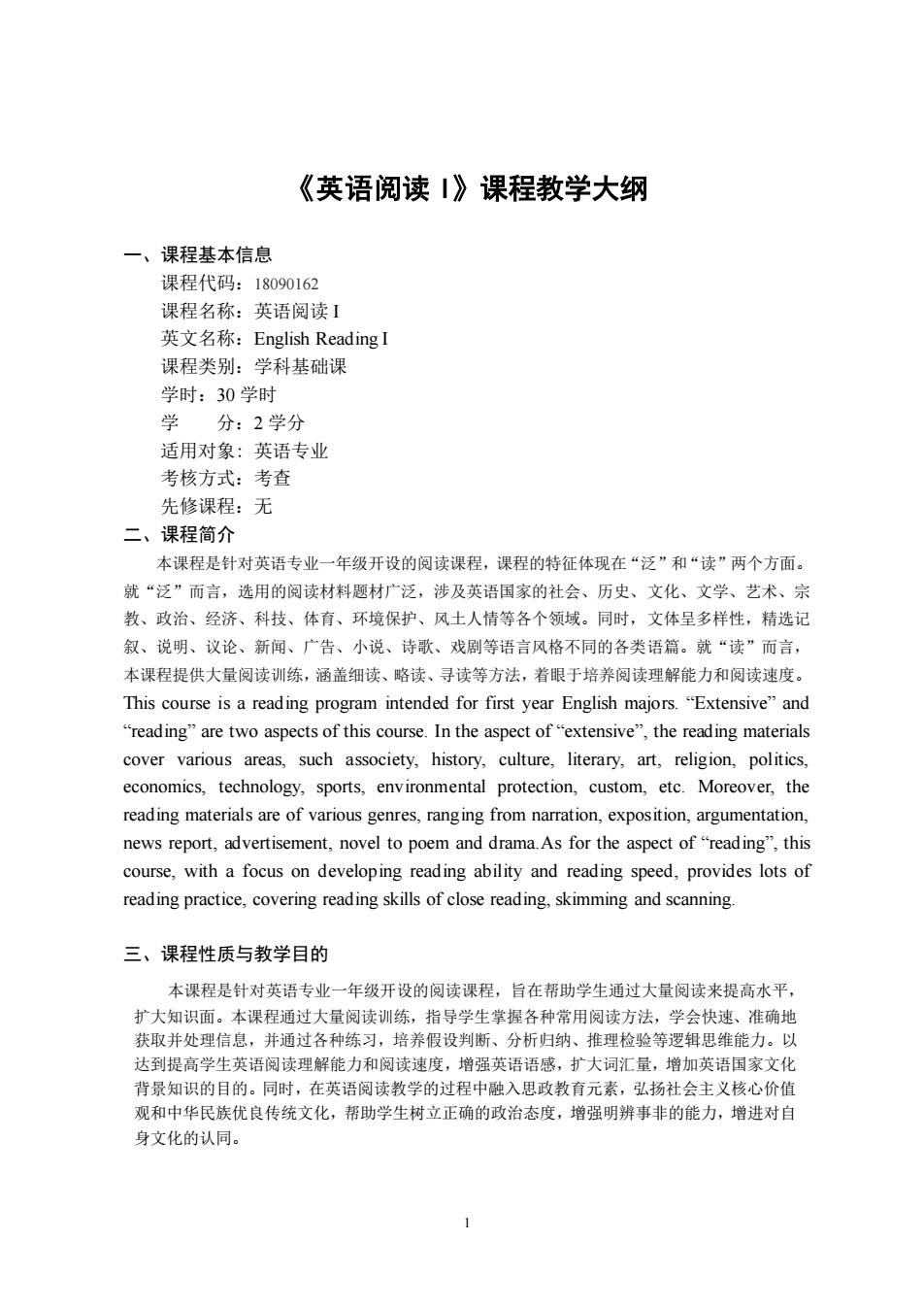
《英语阅读1》课程教学大纲 一、课程基本信息 课程代码:18090162 课程名称:英语阅读I 英文名称:English Reading 课程类别:学科基础课 学时:30学时 学分:2学分 适用对象:英语专业 考核方式:考查 先修课程:无 二、课程简介 本课程是针对英语专业一年级开设的阅读课程,课程的特征体现在“泛”和“读”两个方面。 就“泛”而言,选用的阅读材料题材广泛,涉及英语国家的社会、历史、文化、文学、艺术、宗 教、政治、经济、科技、体有、环境保护、风土人情等各个领域。同时,文体呈多样性,精选记 叙、说明、议论、新闻、广告、小说、诗歌、戏剧等语言风格不同的各类语篇。就“读”而言, 本课程提供大量阅读训练,涵盖细读、略读、寻读等方法,着眼于培养阅读理解能力和阅读速度。 This course is a reading program intended for first year English majors."Extensive"and “reading”are two aspects of this course.In the aspect of“extensive”,the reading materials cover various areas,such associety,history,culture,literary,art,religion,politics economics,technology,sports,environmental protection,custom,etc.Moreover,the reading materials are of various genres,ranging from narration,exposition,argumentation news report,advertisement,novel to poem and drama.As for the aspect of"reading",this course,with a focus on developing reading ability and reading speed,provides lots of reading practice,covering reading skills of close reading,skimming and scanning. 三、课程性质与教学目的 本课程是针对英语专业一年级开设的阅读课程,旨在帮助学生通讨大量阅读来提高水平 扩大知识面。本课程通过大量阅读训练,指导学生掌握各种常用阅读方法,学会快 、准确地 获取并处理信息,并通过各种练习,培养假设判断、分析归钠、推理检验等逻辑思维能力。以 达到提高学生英语阅读理解能力和阅读速度,增强英语语感,扩大词汇量,增加英语国家文化 背景知识的目的。同时,在英语阅读教学的过程中融入思政教育元素,弘扬社会主义核心价值 观和中华民族优良传统文化,帮助学生树立正确的政治态度,增强明辨事非的能力,增进对自 身文化的认同
1 《英语阅读 I》课程教学大纲 一、课程基本信息 课程代码:18090162 课程名称:英语阅读 I 英文名称:English Reading I 课程类别:学科基础课 学时:30 学时 学 分:2 学分 适用对象: 英语专业 考核方式:考查 先修课程:无 二、课程简介 本课程是针对英语专业一年级开设的阅读课程,课程的特征体现在“泛”和“读”两个方面。 就“泛”而言,选用的阅读材料题材广泛,涉及英语国家的社会、历史、文化、文学、艺术、宗 教、政治、经济、科技、体育、环境保护、风土人情等各个领域。同时,文体呈多样性,精选记 叙、说明、议论、新闻、广告、小说、诗歌、戏剧等语言风格不同的各类语篇。就“读”而言, 本课程提供大量阅读训练,涵盖细读、略读、寻读等方法,着眼于培养阅读理解能力和阅读速度。 This course is a reading program intended for first year English majors. “Extensive” and “reading” are two aspects of this course. In the aspect of “extensive”, the reading materials cover various areas, such associety, history, culture, literary, art, religion, politics, economics, technology, sports, environmental protection, custom, etc. Moreover, the reading materials are of various genres, ranging from narration, exposition, argumentation, news report, advertisement, novel to poem and drama.As for the aspect of “reading”, this course, with a focus on developing reading ability and reading speed, provides lots of reading practice, covering reading skills of close reading, skimming and scanning. 三、课程性质与教学目的 本课程是针对英语专业一年级开设的阅读课程,旨在帮助学生通过大量阅读来提高水平, 扩大知识面。本课程通过大量阅读训练,指导学生掌握各种常用阅读方法,学会快速、准确地 获取并处理信息,并通过各种练习,培养假设判断、分析归纳、推理检验等逻辑思维能力。以 达到提高学生英语阅读理解能力和阅读速度,增强英语语感,扩大词汇量,增加英语国家文化 背景知识的目的。同时,在英语阅读教学的过程中融入思政教育元素,弘扬社会主义核心价值 观和中华民族优良传统文化,帮助学生树立正确的政治态度,增强明辨事非的能力,增进对自 身文化的认同
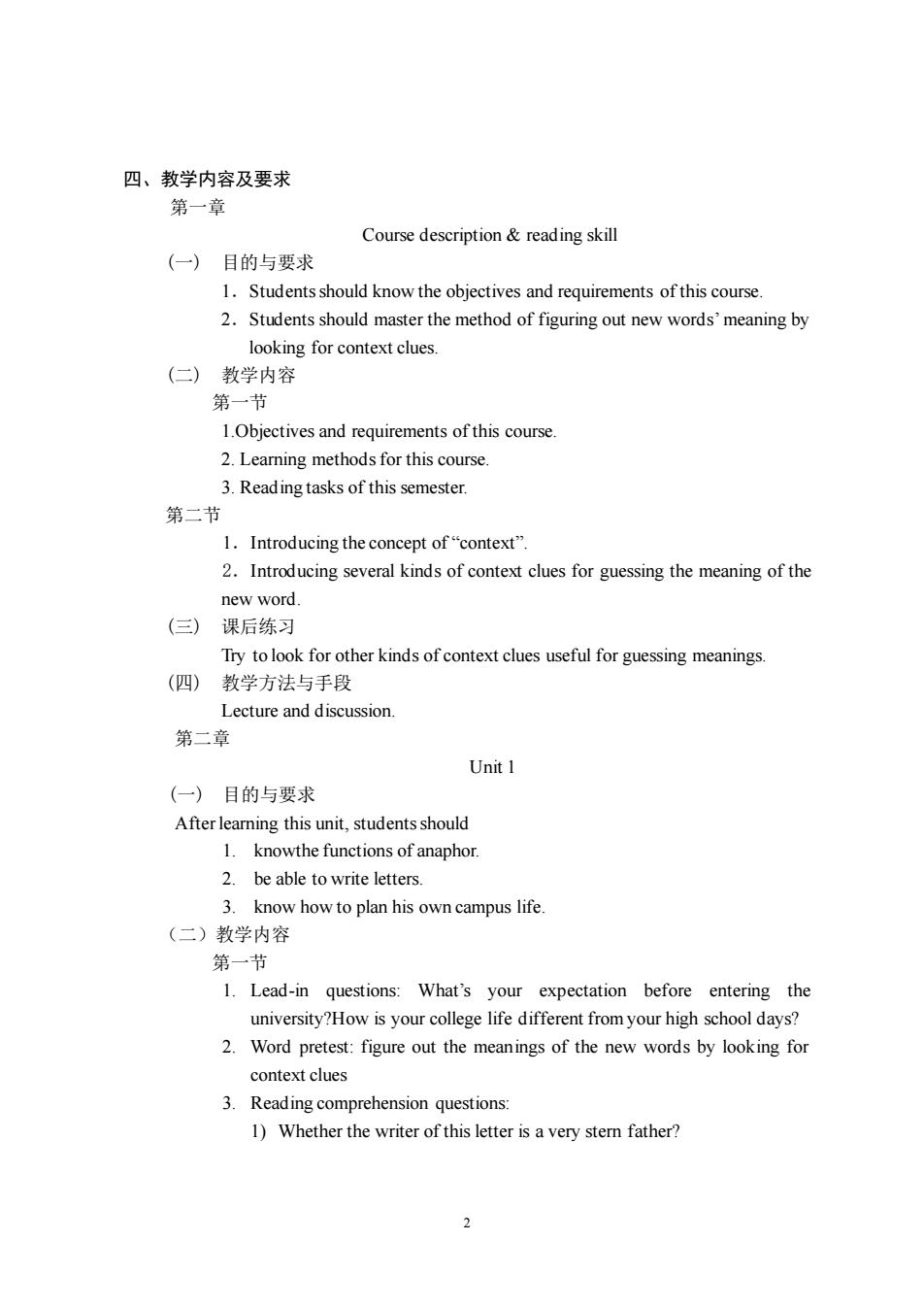
四、教学内容及要求 第一章 Course description&reading skill (一)目的与要求 1.Students should know the objectives and requirements of this course. 2.Students should master the method of figuring out new words'meaning by looking for context clues. (仁)教学内容 第一节 1.Objectives and requirements of this course. 2.Leamning methods for this course. 3.Reading tasks of this semester. 第二节 1.Introducing the concept of"context". 2.Introducing several kinds of context clues for guessing the meaning of the new word (三)课后练习 Try to look for other kinds of context clues useful for guessing meanings. (四)教学方法与手段 Lecture and discussion. 第二章 Unit1 (一)目的与要求 After learning this unit,students should 1.knowthe functions of anaphor 2.be able to write letters. 3.know how to plan his own campus life. (二)教学内容 第一节 1.Lead-in questions:What's your expectation before entering the university?How is your college life different from your high school days? 2.Word pretest:figure out the meanings of the new words by looking for context clues 3.Reading comprehension questions: 1)Whether the writer of this letter is a very stemn father? 2
2 四、教学内容及要求 第一章 Course description & reading skill (一) 目的与要求 1.Students should know the objectives and requirements of this course. 2.Students should master the method of figuring out new words’ meaning by looking for context clues. (二) 教学内容 第一节 1.Objectives and requirements of this course. 2. Learning methods for this course. 3. Reading tasks of this semester. 第二节 1.Introducing the concept of “context”. 2.Introducing several kinds of context clues for guessing the meaning of the new word. (三) 课后练习 Try to look for other kinds of context clues useful for guessing meanings. (四) 教学方法与手段 Lecture and discussion. 第二章 Unit 1 (一) 目的与要求 After learning this unit, students should 1. knowthe functions of anaphor. 2. be able to write letters. 3. know how to plan his own campus life. (二)教学内容 第一节 1. Lead-in questions: What’s your expectation before entering the university?How is your college life different from your high school days? 2. Word pretest: figure out the meanings of the new words by looking for context clues 3. Reading comprehension questions: 1) Whether the writer of this letter is a very stern father?
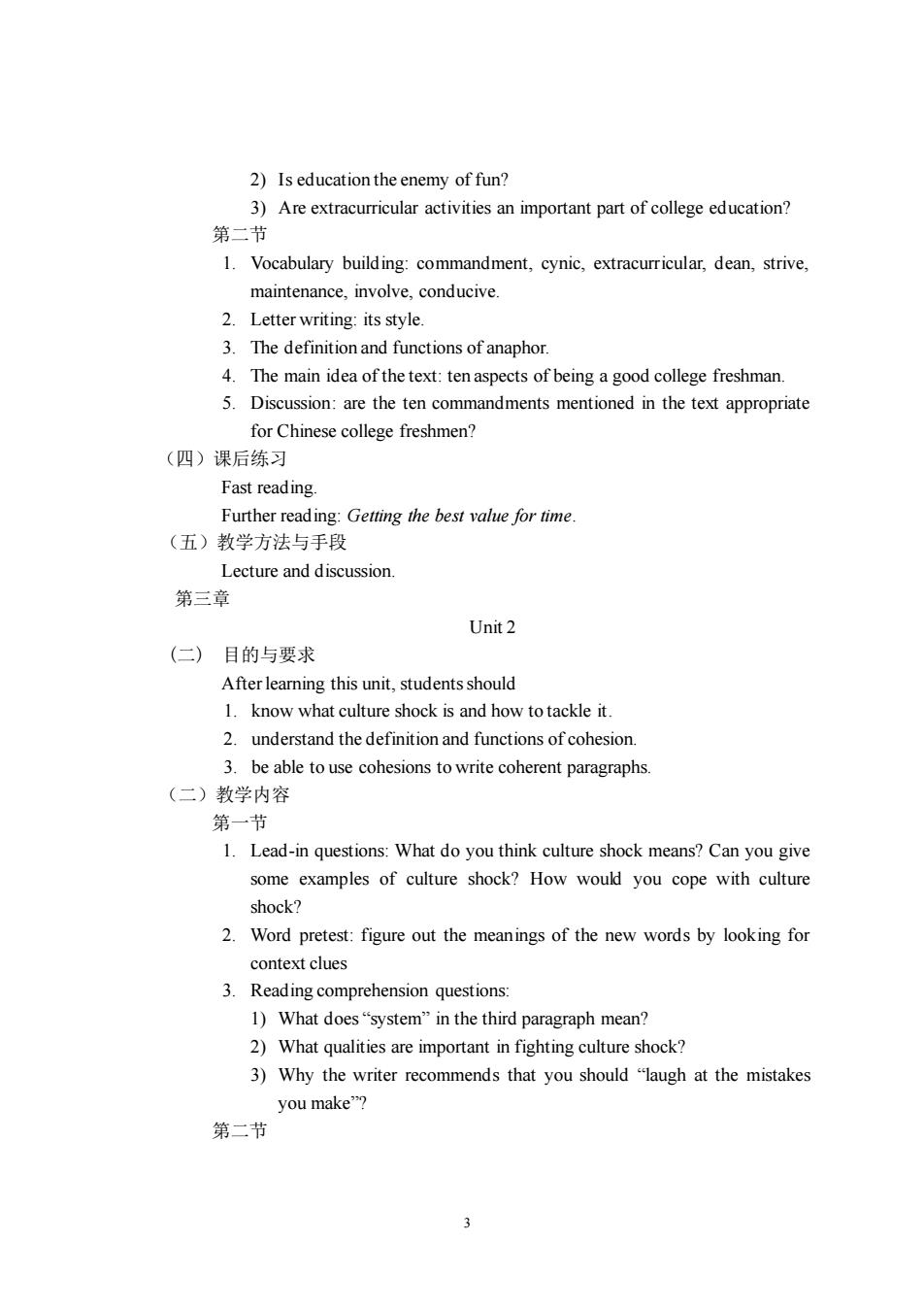
2)Is education the enemy of fun? 3)Are extracurricular activities an important part of college education? 第二节 1.Vocabulary building:commandment,cynic,extracurricular,dean,strive. maintenance,involve,conducive. 2.Letter writing:its style. 3.The definition and functions of anaphor 4.The main idea of the text:ten aspects of being a good college freshman. 5.Discussion:are the ten commandments mentioned in the text appropriate for Chinese college freshmen? (四)课后练习 Fast reading Further reading:Getting the best value for time (五)教学方法与手段 Lecture and discussion 第三章 Unit2 (二)目的与要求 After leaming this unit,students should 1.know what culture shock is and how to tackle it. 2.understand the definition and functions of cohesion 3.be able to use cohesions to write coherent paragraphs (二)教学内容 第一节 1.Lead-in questions:What do you think culture shock means?Can you give some examples of culture shock?How would you cope with culture shock? 2.Word pretest:figure out the meanings of the new words by looking for context clues 3.Reading comprehension questions: 1)What does"system"in the third paragraph mean? 2)What qualities are important in fighting culture shock? 3)Why the writer recommends that you should "laugh at the mistakes you make"? 第二节 3
3 2) Is education the enemy of fun? 3) Are extracurricular activities an important part of college education? 第二节 1. Vocabulary building: commandment, cynic, extracurricular, dean, strive, maintenance, involve, conducive. 2. Letter writing: its style. 3. The definition and functions of anaphor. 4. The main idea of the text: ten aspects of being a good college freshman. 5. Discussion: are the ten commandments mentioned in the text appropriate for Chinese college freshmen? (四)课后练习 Fast reading. Further reading: Getting the best value for time. (五)教学方法与手段 Lecture and discussion. 第三章 Unit 2 (二) 目的与要求 After learning this unit, students should 1. know what culture shock is and how to tackle it. 2. understand the definition and functions of cohesion. 3. be able to use cohesions to write coherent paragraphs. (二)教学内容 第一节 1. Lead-in questions: What do you think culture shock means? Can you give some examples of culture shock? How would you cope with culture shock? 2. Word pretest: figure out the meanings of the new words by looking for context clues 3. Reading comprehension questions: 1) What does “system” in the third paragraph mean? 2) What qualities are important in fighting culture shock? 3) Why the writer recommends that you should “laugh at the mistakes you make”? 第二节
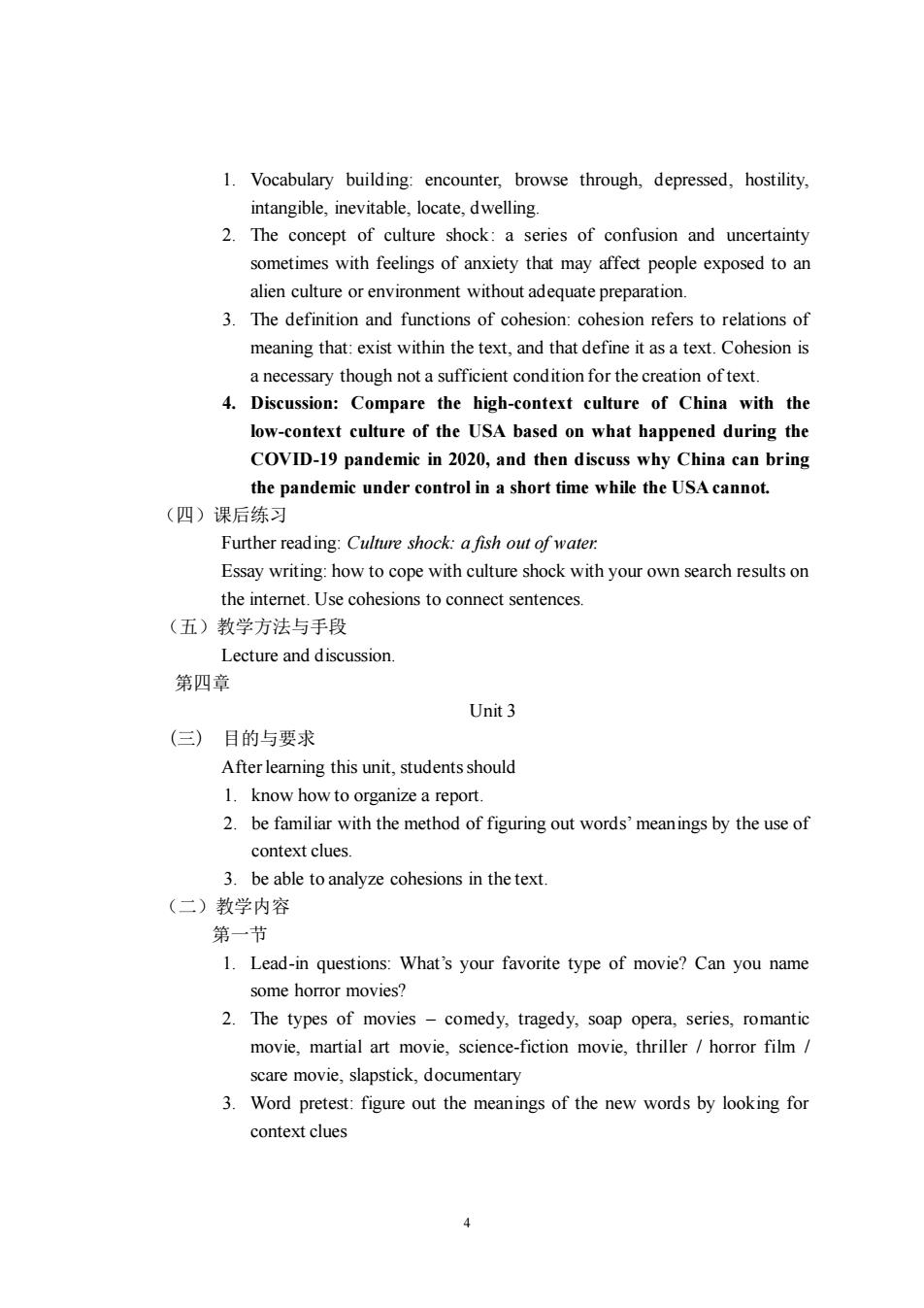
1.Vocabulary building:encounter,browse through,depressed,hostility intangible,inevitable,locate,dwelling. 2.The concept of culture shock:a series of confusion and uncertainty sometimes with feelings of anxiety that may affect people exposed to an alien culture or environment without adequate preparation. 3.The definition and functions of cohesion:cohesion refers to relations of meaning that:exist within the text,and that define it as a text.Cohesion is a necessary though not a sufficient condition for the creation of text. 4.Discussion:Compare the high-context culture of China with the low-context culture of the USA based on what happened during the COVID-19 pandemic in 2020,and then discuss why China can bring the pandemic under control in a short time while the USA cannot. (四)课后练习 Further read ing:Culture shock:a fish out of water Essay writing:how to cope with culture shock with your own search results on the internet.Use cohesions to connect sentences. (五)教学方法与手段 Lecture and discussion. 第四章 Unit 3 (三)目的与要求 After learning this unit,students should 1.know how to organize a report. 2.be familiar with the method of figuring out words'meanings by the use of context clues 3.be able to analyze cohesions in the text. (二)教学内容 第一节 1.Lead-in questions:What's your favorite type of movie?Can you name some horror movies? 2.The types of movies-comedy,tragedy,soap opera,series,romantic movie,martial art movie,science-fiction movie,thriller /horror film/ scare movie,slapstick,documentary 3.Word pretest:figure out the meanings of the new words by looking for context clues 4
4 1. Vocabulary building: encounter, browse through, depressed, hostility, intangible, inevitable, locate, dwelling. 2. The concept of culture shock: a series of confusion and uncertainty sometimes with feelings of anxiety that may affect people exposed to an alien culture or environment without adequate preparation. 3. The definition and functions of cohesion: cohesion refers to relations of meaning that: exist within the text, and that define it as a text. Cohesion is a necessary though not a sufficient condition for the creation of text. 4. Discussion: Compare the high-context culture of China with the low-context culture of the USA based on what happened during the COVID-19 pandemic in 2020, and then discuss why China can bring the pandemic under control in a short time while the USA cannot. (四)课后练习 Further reading: Culture shock: a fish out of water. Essay writing: how to cope with culture shock with your own search results on the internet. Use cohesions to connect sentences. (五)教学方法与手段 Lecture and discussion. 第四章 Unit 3 (三) 目的与要求 After learning this unit, students should 1. know how to organize a report. 2. be familiar with the method of figuring out words’ meanings by the use of context clues. 3. be able to analyze cohesions in the text. (二)教学内容 第一节 1. Lead-in questions: What’s your favorite type of movie? Can you name some horror movies? 2. The types of movies – comedy, tragedy, soap opera, series, romantic movie, martial art movie, science-fiction movie, thriller / horror film / scare movie, slapstick, documentary 3. Word pretest: figure out the meanings of the new words by looking for context clues
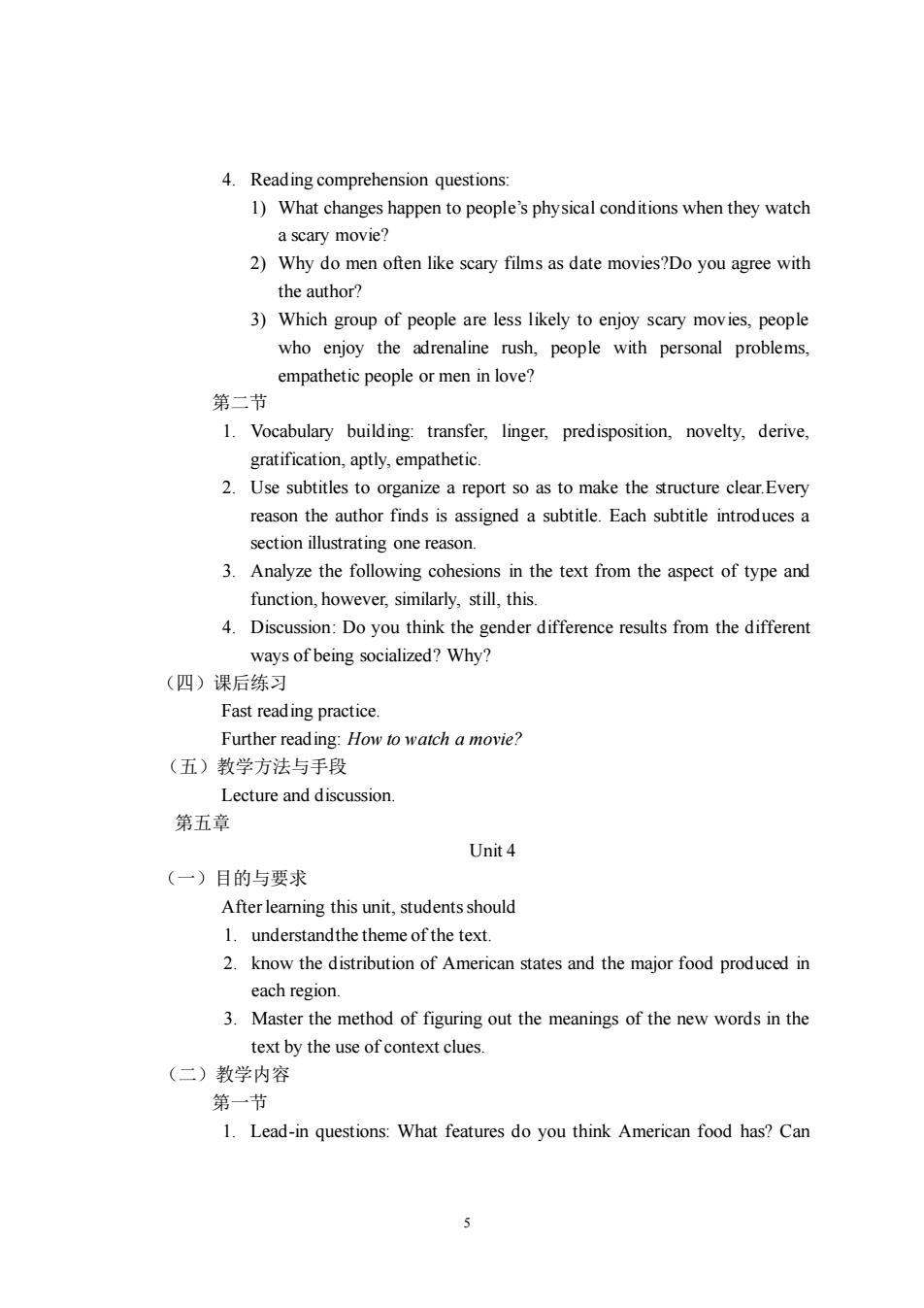
4.Reading comprehension questions: 1)What changes happen to people's physical conditions when they watch a scary movie? 2)Why do men often like scary films as date movies?Do you agree with the author? 3)Which group of people are less likely to enjoy scary movies,people who enjoy the adrenaline rush,people with personal problems empathetic people or men in love? 第二节 1.Vocabulary building:transfer,linger,predisposition,novelty,derive, gratification,aptly,empathetic. 2.Use subtitles to organize a report so as to make the structure clear.Every reason the author finds is assigned a subtitle.Each subtitle introduces a section illustrating one reason. 3.Analyze the following cohesions in the text from the aspect of type and function,however,similarly,still,this. 4. Discussion:Do you think the gender difference results from the different ways of being socialized?Why? (四)课后练习 Fast reading practice. Further reading:How to watch a movie? (五)教学方法与手段 Lecture and discussion 第五章 Unit4 (一)目的与要求 After learning this unit,students should 1.understandthe theme of the text. 2.know the distribution of American states and the major food produced in each region. 3.Master the method of figuring out the meanings of the new words in the text by the use of context clues (二)教学内容 第一节 1.Lead-in questions:What features do you think American food has?Can
5 4. Reading comprehension questions: 1) What changes happen to people’s physical conditions when they watch a scary movie? 2) Why do men often like scary films as date movies?Do you agree with the author? 3) Which group of people are less likely to enjoy scary movies, people who enjoy the adrenaline rush, people with personal problems, empathetic people or men in love? 第二节 1. Vocabulary building: transfer, linger, predisposition, novelty, derive, gratification, aptly, empathetic. 2. Use subtitles to organize a report so as to make the structure clear.Every reason the author finds is assigned a subtitle. Each subtitle introduces a section illustrating one reason. 3. Analyze the following cohesions in the text from the aspect of type and function, however, similarly, still, this. 4. Discussion: Do you think the gender difference results from the different ways of being socialized? Why? (四)课后练习 Fast reading practice. Further reading: How to watch a movie? (五)教学方法与手段 Lecture and discussion. 第五章 Unit 4 (一)目的与要求 After learning this unit, students should 1. understandthe theme of the text. 2. know the distribution of American states and the major food produced in each region. 3. Master the method of figuring out the meanings of the new words in the text by the use of context clues. (二)教学内容 第一节 1. Lead-in questions: What features do you think American food has? Can
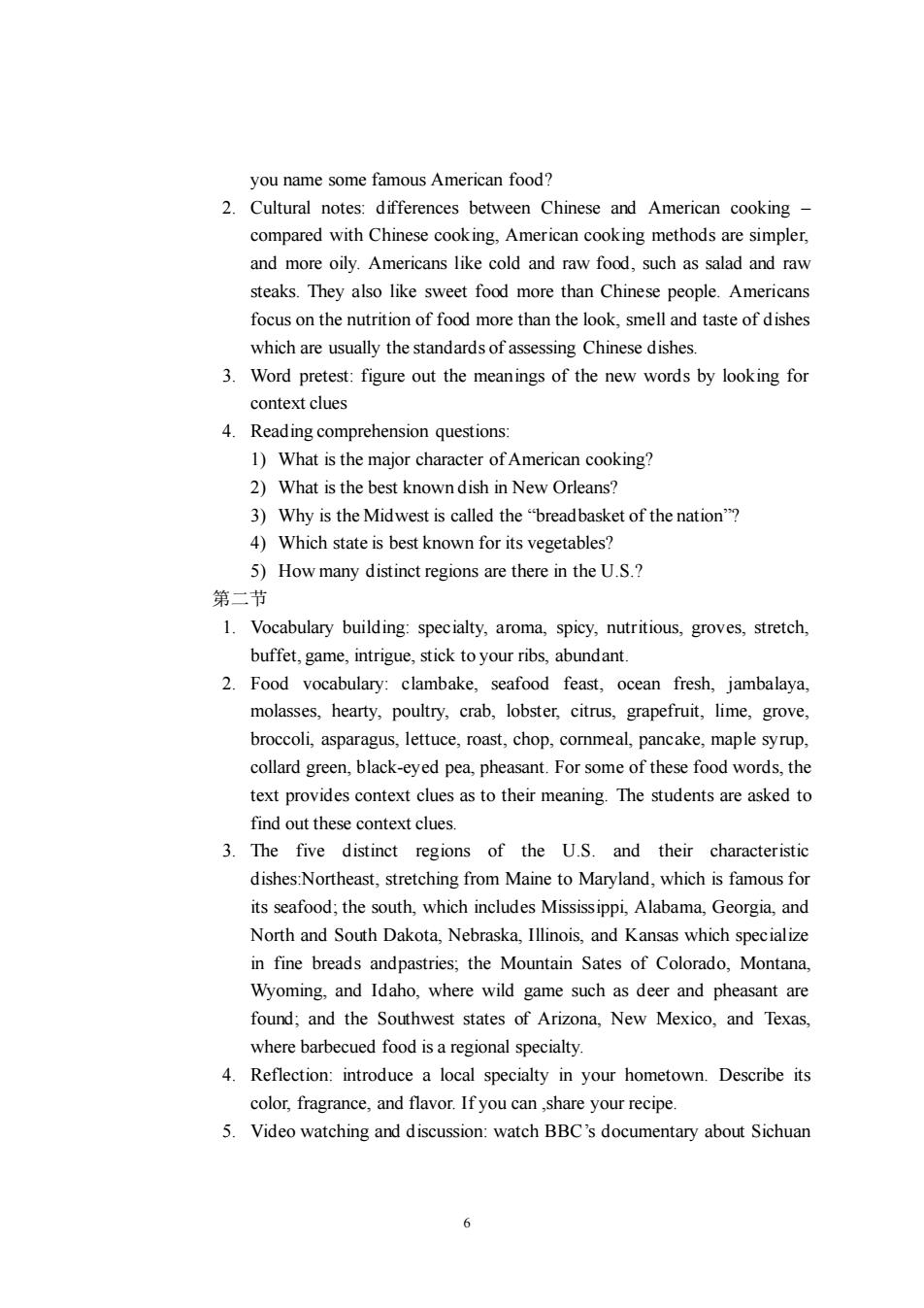
you name some famous american food? 2.Cultural notes:differences between Chinese and American cooking- compared with Chinese cooking,American cooking methods are simpler, and more oily.Americans like cold and raw food,such as salad and raw steaks.They also like sweet food more than Chinese people.Americans focus on the nutrition of food more than the look,smell and taste of dishes which are usually the standards of assessing Chinese dishes. 3.Word pretest:figure out the meanings of the new words by looking for context clues 4.Reading comprehension questions: 1)What is the major character of American cooking? 2)What is the best known dish in New Orleans? 3)Why is the Midwest is called the"breadbasket of the nation"? 4)Which state is best known for its vegetables? 5)How many distinct regions are there in the U.S.? 第二节 1.Vocabulary building:specialty,aroma,spicy,nutritious,groves,stretch buffet,game,intrigue,stick to your ribs,abundant. 2. Food vocabulary:clambake,seafood feast,ocean fresh,jambalaya, molasses,hearty,poultry,crab,lobster,citrus,grapefruit,lime,grove, broccoli,asparagus,lettuce,roast,chop,commeal,pancake,maple syrup. collard green.black-eved pea.pheasant.For some of these food words.the text provides context clues as to their meaning.The students are asked to find out these context clues. 3.The five distinct regions of the U.S.and their characteristic dishes:Northeast,stretching from Maine to Maryland,which is famous for its seafood;the south,which includes Mississippi,Alabama,Georgia,and North and South Dakota,Nebraska,Illinois,and Kansas which specialize in fine breads andpastries;the Mountain Sates of Colorado,Montana, Wyoming,and Idaho,where wild game such as deer and pheasant are found;and the Southwest states of Arizona,New Mexico,and Texas, where barbecued food is a regional specialty. 4.Reflection:introduce a local specialty in your hometown.Describe its color,fragrance,and flavor.Ifyou canshare your recipe. 5.Video watching and discussion:watch BBC's documentary about Sichuan 6
6 you name some famous American food? 2. Cultural notes: differences between Chinese and American cooking – compared with Chinese cooking, American cooking methods are simpler, and more oily. Americans like cold and raw food, such as salad and raw steaks. They also like sweet food more than Chinese people. Americans focus on the nutrition of food more than the look, smell and taste of dishes which are usually the standards of assessing Chinese dishes. 3. Word pretest: figure out the meanings of the new words by looking for context clues 4. Reading comprehension questions: 1) What is the major character of American cooking? 2) What is the best known dish in New Orleans? 3) Why is the Midwest is called the “breadbasket of the nation”? 4) Which state is best known for its vegetables? 5) How many distinct regions are there in the U.S.? 第二节 1. Vocabulary building: specialty, aroma, spicy, nutritious, groves, stretch, buffet, game, intrigue, stick to your ribs, abundant. 2. Food vocabulary: clambake, seafood feast, ocean fresh, jambalaya, molasses, hearty, poultry, crab, lobster, citrus, grapefruit, lime, grove, broccoli, asparagus, lettuce, roast, chop, cornmeal, pancake, maple syrup, collard green, black-eyed pea, pheasant. For some of these food words, the text provides context clues as to their meaning. The students are asked to find out these context clues. 3. The five distinct regions of the U.S. and their characteristic dishes:Northeast, stretching from Maine to Maryland, which is famous for its seafood; the south, which includes Mississippi, Alabama, Georgia, and North and South Dakota, Nebraska, Illinois, and Kansas which specialize in fine breads andpastries; the Mountain Sates of Colorado, Montana, Wyoming, and Idaho, where wild game such as deer and pheasant are found; and the Southwest states of Arizona, New Mexico, and Texas, where barbecued food is a regional specialty. 4. Reflection: introduce a local specialty in your hometown. Describe its color, fragrance, and flavor. If you can ,share your recipe. 5. Video watching and discussion: watch BBC’s documentary about Sichuan
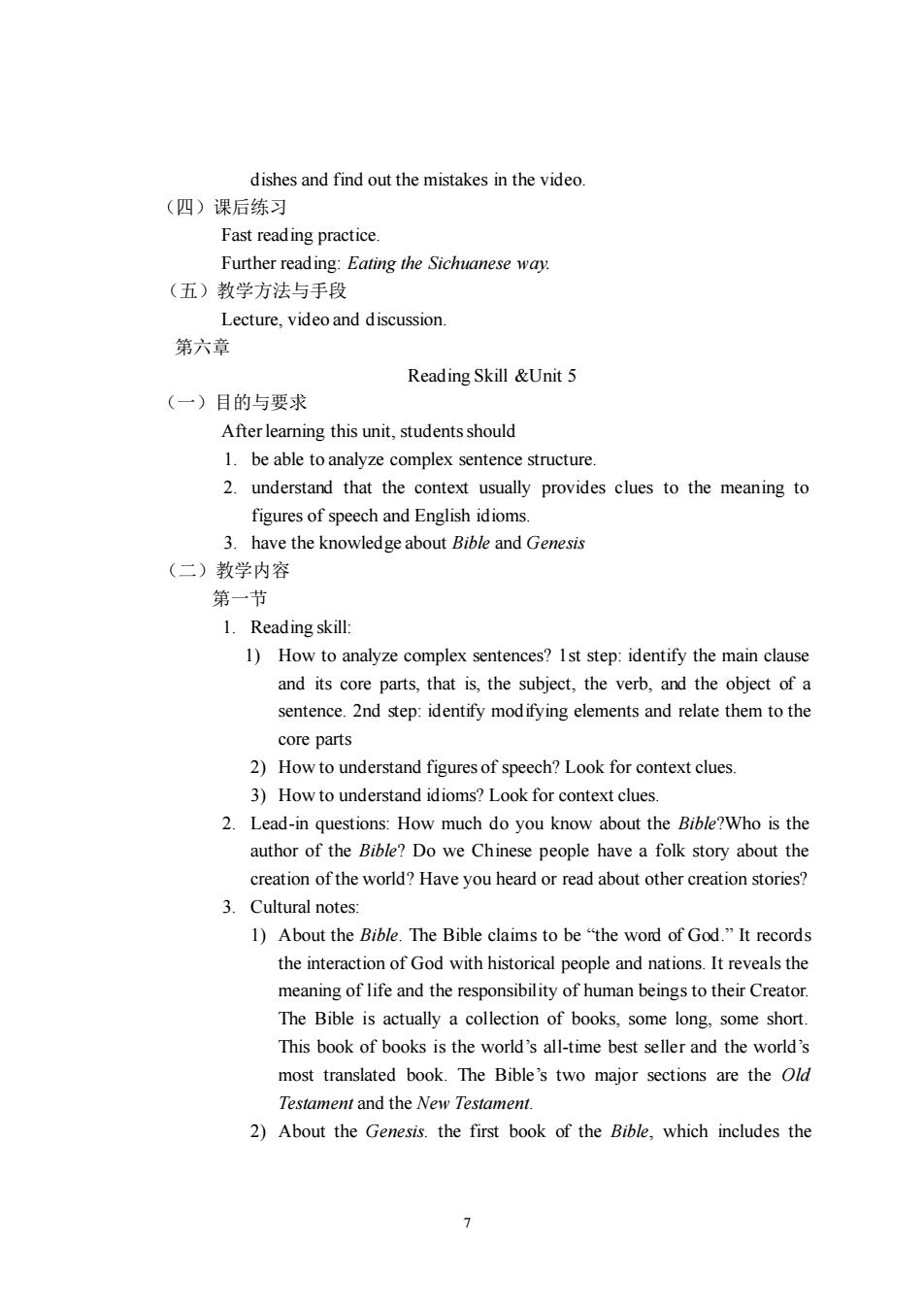
dishes and find out the mistakes in the video (四)课后练习 Fast read ing practice Further reading:Eating the Sichuanese way. (五)教学方法与手段 Lecture,video and discussion. 第六章 Reading Skill &Unit 5 (一)目的与要求 After learning this unit.students should 1.be able to analyze complex sentence structure 2.understand that the context usually provides clues to the meaning to figures of speech and English idioms 3.have the knowledge about Bible and Genesis (二)教学内容 第一节 1.Reading skill: 1)How to analyze complex sentences?Ist step:identify the main clause and its core parts,that is,the subject,the verb,and the object of a sentence.2nd step:identify mod ifying elements and relate them to the core parts 2)How to understand figures of speech?Look for context clues. 3)How to understand idioms?Look for context clues. 2.Lead-in questions:How much do you know about the Bible?Who is the author of the Bible?Do we Chinese people have a folk story about the creation of the world?Have you heard or read about other creation stories? 3.Cultural notes: 1)About the Bible.The Bible claims to be"the word of God."It records the interaction of God with historical people and nations.It reveals the meaning of life and the responsibility of human beings to their Creator. The Bible is actually a collection of books.some long.some short This book of books is the world's all-time best seller and the world's most translated book.The Bible's two major sections are the Old Testament and the New Testament 2)About the Genesis.the first book of the Bible,which includes the 7
7 dishes and find out the mistakes in the video. (四)课后练习 Fast reading practice. Further reading: Eating the Sichuanese way. (五)教学方法与手段 Lecture, video and discussion. 第六章 Reading Skill &Unit 5 (一)目的与要求 After learning this unit, students should 1. be able to analyze complex sentence structure. 2. understand that the context usually provides clues to the meaning to figures of speech and English idioms. 3. have the knowledge about Bible and Genesis (二)教学内容 第一节 1. Reading skill: 1) How to analyze complex sentences? 1st step: identify the main clause and its core parts, that is, the subject, the verb, and the object of a sentence. 2nd step: identify modifying elements and relate them to the core parts 2) How to understand figures of speech? Look for context clues. 3) How to understand idioms? Look for context clues. 2. Lead-in questions: How much do you know about the Bible?Who is the author of the Bible? Do we Chinese people have a folk story about the creation of the world? Have you heard or read about other creation stories? 3. Cultural notes: 1) About the Bible. The Bible claims to be “the word of God.” It records the interaction of God with historical people and nations. It reveals the meaning of life and the responsibility of human beings to their Creator. The Bible is actually a collection of books, some long, some short. This book of books is the world’s all-time best seller and the world’s most translated book. The Bible’s two major sections are the Old Testament and the New Testament. 2) About the Genesis. the first book of the Bible, which includes the
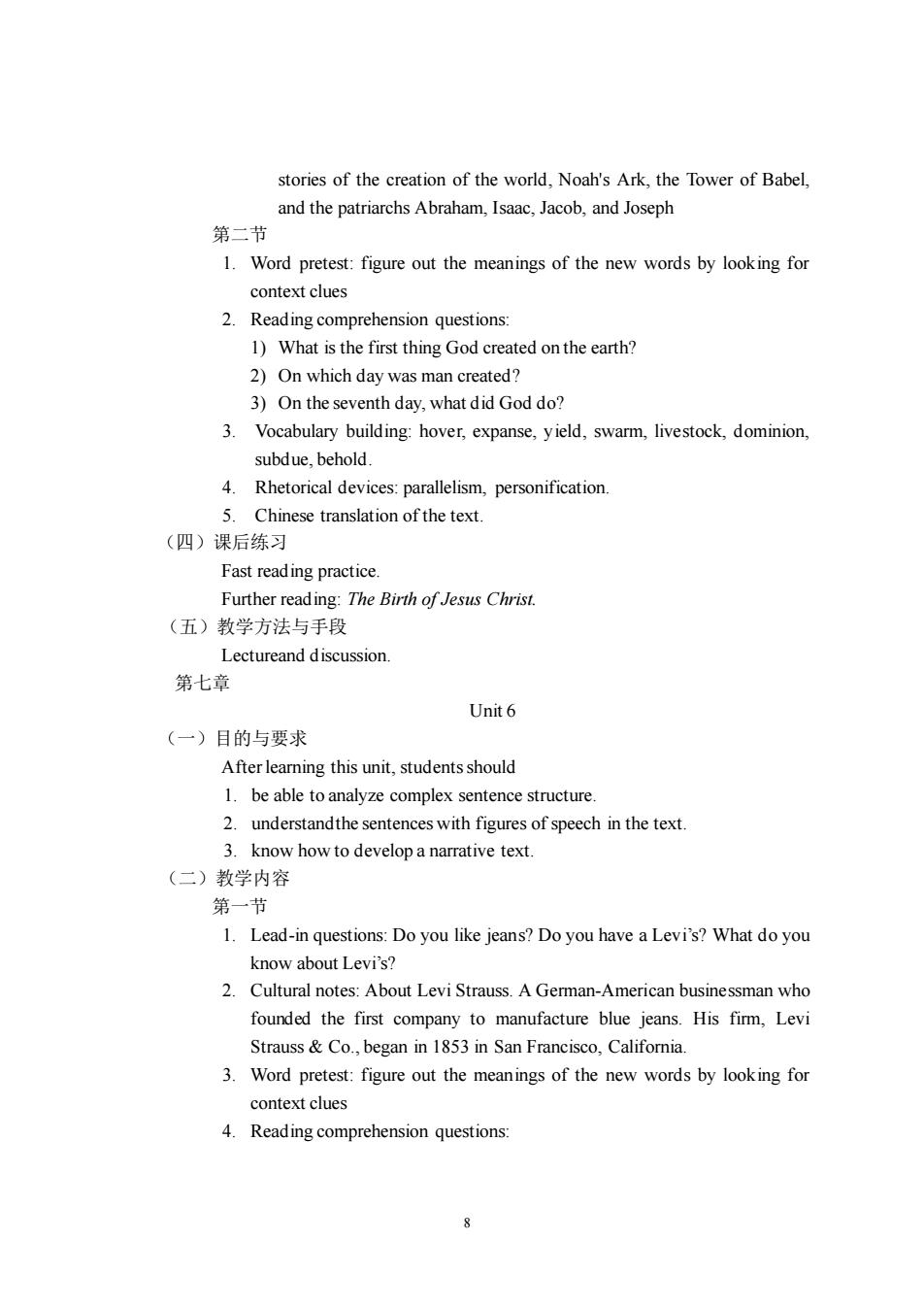
stories of the creation of the world,Noah's Ark,the Tower of Babel, and the patriarchs Abraham,Isaac,Jacob,and Joseph 第二节 1.Word pretest:figure out the meanings of the new words by looking for context clues 2.Reading comprehension questions: 1)What is the first thing God created on the earth? 2)On which day was man created? 3)On the seventh day,what did God do? 3.Vocabulary building:hover,expanse,yield,swarm,livestock,dominion, subdue hehold 4.Rhetorical devices:parallelism,personification. 5.Chinese translation of the text. (四)课后练习 Fast reading practice Further read ing:The Birth of Jesus Christ (五)教学方法与手段 Lectureand discussion. 第七章 Unit 6 (一)目的与要求 After leamning this unit,students should 1.be able to analyze complex sentence structure. 2.understandthe sentences with figures of speech in the text. 3.know how to develop a narrative text (二)教学内容 第一节 1.Lead-in questions:Do you like jeans?Do you have a Levi's?What do you know about Levi's? 2.Cultural notes:About Levi Strauss.A German-American businessman who founded the first company to manufacture blue jeans.His firm,Levi Strauss Co.,began in 1853 in San Francisco,California. 3.Word pretest:figure out the meanings of the new words by looking for context clues 4.Reading comprehension questions: 8
8 stories of the creation of the world, Noah's Ark, the Tower of Babel, and the patriarchs Abraham, Isaac, Jacob, and Joseph 第二节 1. Word pretest: figure out the meanings of the new words by looking for context clues 2. Reading comprehension questions: 1) What is the first thing God created on the earth? 2) On which day was man created? 3) On the seventh day, what did God do? 3. Vocabulary building: hover, expanse, yield, swarm, livestock, dominion, subdue, behold. 4. Rhetorical devices: parallelism, personification. 5. Chinese translation of the text. (四)课后练习 Fast reading practice. Further reading: The Birth of Jesus Christ. (五)教学方法与手段 Lectureand discussion. 第七章 Unit 6 (一)目的与要求 After learning this unit, students should 1. be able to analyze complex sentence structure. 2. understandthe sentences with figures of speech in the text. 3. know how to develop a narrative text. (二)教学内容 第一节 1. Lead-in questions: Do you like jeans? Do you have a Levi’s? What do you know about Levi’s? 2. Cultural notes: About Levi Strauss. A German-American businessman who founded the first company to manufacture blue jeans. His firm, Levi Strauss & Co., began in 1853 in San Francisco, California. 3. Word pretest: figure out the meanings of the new words by looking for context clues 4. Reading comprehension questions:
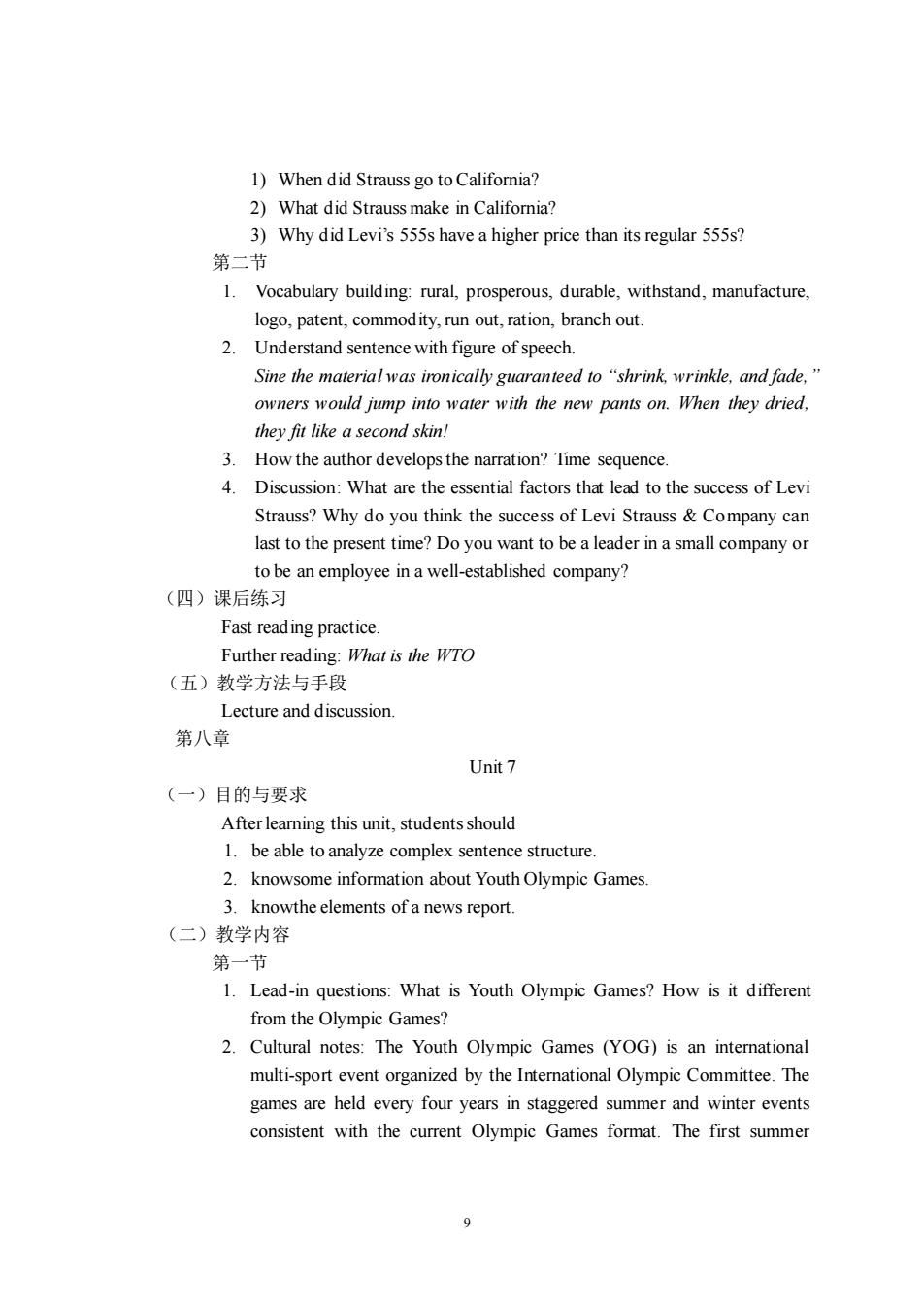
1)When did Strauss go to California? 2)What did Strauss make in California? 3)Why did Levi's 555s have a higher price than its regular 555s? 第二节 1.Vocabulary building:rural,prosperous,durable,withstand,manufacture, logo,patent,commodity,run out,ration,branch out 2.Understand sentence with figure of speech. Sine the materialwas ironically guaranteed to "shrink.wrinkle,and fade. owners would jump into water with the new pants on.When they dried. they fit like a second skin! 3.How the author develops the narration?Time sequence 4.Discussion:What are the essential factors that lead to the success of Levi Strauss?Why do you think the success of Levi Strauss&Company can last to the present time?Do you want to be a leader in a small company or to be an employee in a well-established company? (四)课后练习 Fast reading practice Further reading:What is the WTO (五)教学方法与手段 Lecture and discussion. 第八章 Unit7 (一)目的与要求 After leamning this unit,studentsshould 1.be able to analyze complex sentence structure. 2.knowsome information about Youth Olympic Games 3.knowthe elements of a news report. (二)教学内容 第一节 1.Lead-in questions:What is Youth Olympic Games?How is it different from the Olympic Games? 2.Cultural notes:The Youth Olympic Games (YOG)is an interational multi-sport event organized by the International Olympic Committee.The games are held every four years in staggered summer and winter events consistent with the current Olympic Games format.The first summer
9 1) When did Strauss go to California? 2) What did Strauss make in California? 3) Why did Levi’s 555s have a higher price than its regular 555s? 第二节 1. Vocabulary building: rural, prosperous, durable, withstand, manufacture, logo, patent, commodity, run out, ration, branch out. 2. Understand sentence with figure of speech. Sine the material was ironically guaranteed to “shrink, wrinkle, and fade,” owners would jump into water with the new pants on. When they dried, they fit like a second skin! 3. How the author develops the narration? Time sequence. 4. Discussion: What are the essential factors that lead to the success of Levi Strauss? Why do you think the success of Levi Strauss & Company can last to the present time? Do you want to be a leader in a small company or to be an employee in a well-established company? (四)课后练习 Fast reading practice. Further reading: What is the WTO (五)教学方法与手段 Lecture and discussion. 第八章 Unit 7 (一)目的与要求 After learning this unit, students should 1. be able to analyze complex sentence structure. 2. knowsome information about Youth Olympic Games. 3. knowthe elements of a news report. (二)教学内容 第一节 1. Lead-in questions: What is Youth Olympic Games? How is it different from the Olympic Games? 2. Cultural notes: The Youth Olympic Games (YOG) is an international multi-sport event organized by the International Olympic Committee. The games are held every four years in staggered summer and winter events consistent with the current Olympic Games format. The first summer

version was held in Singapore from 14 to 26 August 2010 while the first winter version was held in Innsbruck,Austria from 13 to 22 January 2012. The age limitation of the athletes is 14 to 18. 3.Word pretest:figure out the meanings of the new words by looking for context clues 4.Reading comprehension questions: 1)Where did IOC President declared Nanjing the winning bidder of 2014 YOG? 2)Why did Guadalajara dropped out ofthe bidding? 3)When and where was the first YOG held? 4)What was the motto for Nanjing 2014 YOG? 5)How many venues did theIOC require for the YOG? 第二节 1.Vocabulary building:cite,inaugural,core,venue,obligation,stipulation, boast,legacy 2.Elements of a news report:name of the news agency,news lead which tells the main facts of the news story concisely.the main part of the news report conclusion 3.Discussion:Compare the achievements of Chinese athletes in Olympic Games before and after the liberation,and discuss the reasons leading the difference. (四)课后练习 Further reading:How the Olympic Games started? Report writing:write a report on the history of the YOG (五)教学方法与手段 Lecture and discussion. 第九章 Unit 8 (一)目的与要求 After learning this unit,students should 1.be able to analyze complex sentence structure 2.knowthe structure of the text. 3.be familiar with the structure ofan exposition. (二)教学内容 第一节 10
10 version was held in Singapore from 14 to 26 August 2010 while the first winter version was held in Innsbruck, Austria from 13 to 22 January 2012. The age limitation of the athletes is 14 to 18. 3. Word pretest: figure out the meanings of the new words by looking for context clues 4. Reading comprehension questions: 1) Where did IOC President declared Nanjing the winning bidder of 2014 YOG? 2) Why did Guadalajara dropped out of the bidding? 3) When and where was the first YOG held? 4) What was the motto for Nanjing 2014 YOG? 5) How many venues did the IOC require for the YOG? 第二节 1. Vocabulary building: cite, inaugural, core, venue, obligation, stipulation, boast, legacy. 2. Elements of a news report: name of the news agency, news lead which tells the main facts of the news story concisely, the main part of the news report, conclusion. 3. Discussion: Compare the achievements of Chinese athletes in Olympic Games before and after the liberation, and discuss the reasons leading the difference. (四)课后练习 Further reading: How the Olympic Games started? Report writing: write a report on the history of the YOG. (五)教学方法与手段 Lecture and discussion. 第九章 Unit 8 (一)目的与要求 After learning this unit, students should 1. be able to analyze complex sentence structure. 2. knowthe structure of the text. 3. be familiar with the structure of an exposition. (二)教学内容 第一节